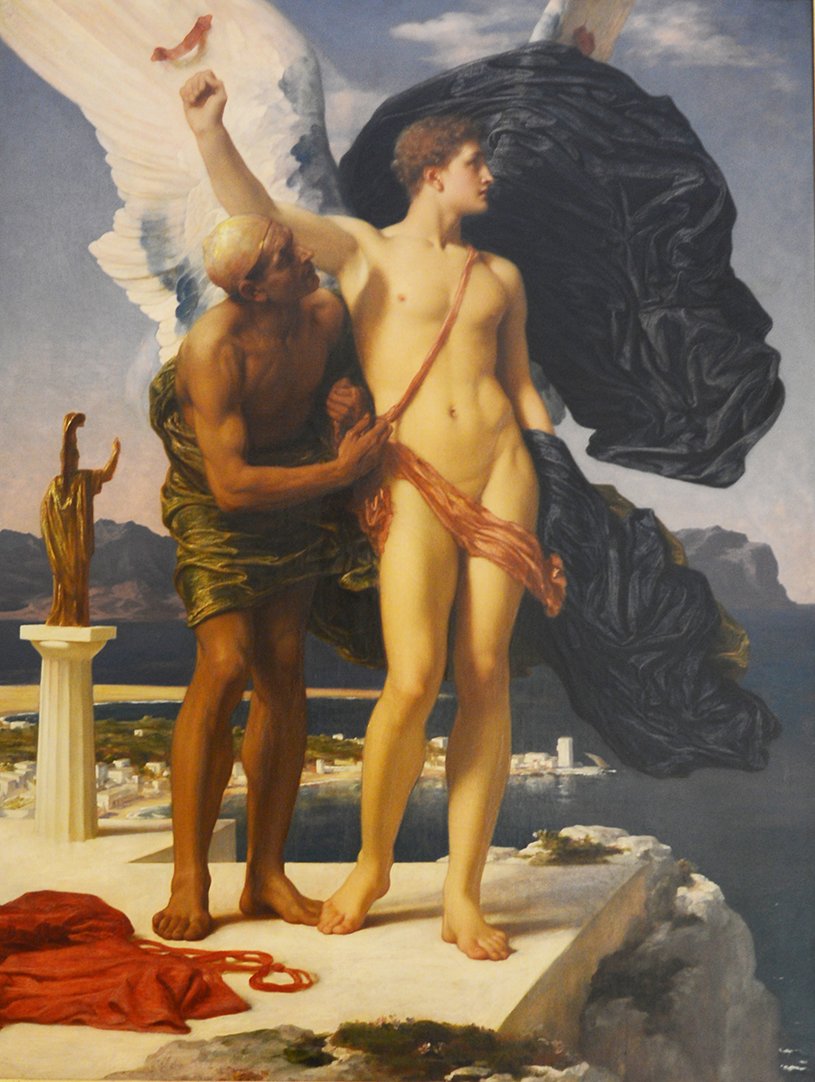
Daedalus and Icarus
1839-96
Oil on canvas, 54 1/2 ins by 41 ins
Collection Details
With Thomas Eustace Smith of Gosforth Hall, Newcastle, by 1873; purchased by Alexander Henderson, later 1st Baron Faringdon by private sale, 1887; included in his sale, Sotheby’s, 13 June 1934, lot 117; bought by Gavin, 2nd Baron Faringdon.
Literature
E Rhys, Lord Leighton, 1900, pp.26, 124, repd; Mrs Barrington, Frederick Leighton, 1906, ii, pp.188–9; L and R Ormond, Lord Leighton, 1975, pp.88–9, 95, 96, 119, 160, No.186, Pl.112.
Exhibition Details
RA, 1869, No.469; RA, Winter, 1897, No.69; Manchester City Art Gallery, Minneapolis Institute and Brooklyn Museum, Victorian High Renaissance, 1978, No.50; Frederic, Lord Leighton, Royal Academy of Art, London, January-May 1996; Queer British Art, Tate Britain, 2017.
Related Picture
There is a small colour sketch at Leighton House (369).
Background
The Ormonds (Victorian High Renaissance, 1978) suggest that Leighton used Ovid as his source for the famous legend. The inventor Dædalus is here shown helping his son Icarus to put on the wings he had made from wax and feathers to aid their escape from imprisonment in the Labyrinth, which Dædalus had himself devised for King Minos of Crete. Icarus rashly flew too close to the sun, his wings melted and he drowned in the sea near the island of Samos.
The subject has often been treated by artists, for example, van Dyck (Toronto Art Gallery; copy on loan to Hatchlands, NT) and Canova, since it provides an admirable pretext for contrasting the aged and youthful nude male form. But Leighton was also interested in the setting: the appropriately sunlit landscape was based on studies he had made on the island of Rhodes in 1867. The rich colour heralds the style of Leighton’s later works of the 1880s.
The picture was exhibited at the Royal Academy to general acclamation in the year that Leighton was elected a full Academician. Only The Times dissented, complaining that the contrast of dark and pale skin was a stale device, and that the failure to show Icarus’s pectoral muscles suggested instead: ‘the soft, round contour of a feminine breast’.
Lord Faringdon (then still Alexander Henderson) would also have owned Leighton’s vast painting of The Captive Andromache (1888), if it had not been bought for Manchester City Art Gallery.
The Trustees of the Faringdon Collection 25.
All rights reserved.
